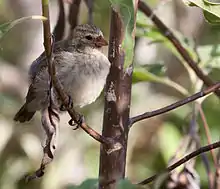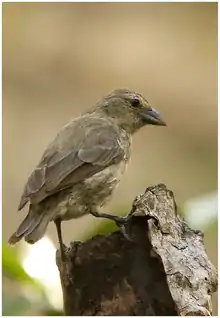Camarhynchus
Camarhynchus is a genus of birds in the tanager family Thraupidae. All species of Camarhynchus are endemic to the Galápagos Islands, and together with related genera they are collectively known as Darwin's finches.[1] Formerly classified in the bunting and American sparrow family Emberizidae, more recent molecular genetic studies have shown it to belong in the tanager family.
| Camarhynchus | |
|---|---|
 | |
| Medium tree finch (Camarhynchus pauper) | |
| Scientific classification | |
| Kingdom: | Animalia |
| Phylum: | Chordata |
| Class: | Aves |
| Order: | Passeriformes |
| Family: | Thraupidae |
| Genus: | Camarhynchus Gould, 1837 |
| Type species | |
| Camarhynchus psittacula Gould, 1837 | |
Taxonomy and species list
The genus Camarhynchus was introduced in 1837 by the English ornithologist John Gould with the large tree finch as the type species.[2] The name combines the Ancient Greek kamara meaning "arch" or "vault" with rhunkhos meaning "bill".[3] The members of the genus form part of a group collectively known as Darwin's finches.[4] Although traditionally placed with the buntings and New World sparrows in the family Emberizidae,[5] molecular phylogenetic studies have shown that Darwin's finches are members of the subfamily Coerebinae within the tanager family Thraupidae.[6] The genus contains five species.[7]
| Image | Scientific name | Common Name | Distribution |
|---|---|---|---|
 | Camarhynchus parvulus | Small tree finch | Galapagos Islands. |
 | Camarhynchus pauper | Medium tree finch | Galápagos Islands where it is only found on Floreana Island |
 | Camarhynchus psittacula | Large tree finch | Galapagos Islands |
 | Camarhynchus pallidus | Woodpecker finch | Galapagos Islands |
 | Camarhynchus heliobates | Mangrove finch | Galápagos Islands |
The vegetarian finch (Platyspiza crassirostris) has sometimes been included in this genus.
References
- White, Mel (11 May 2015). "A Darwin Finch, Crucial to Idea of Evolution, Fights for Survival". National Geographic. Retrieved 18 January 2016.
- Gould, John (1837). "Remarks on a group of ground finches from Mr. Darwin's collection, with characters of new species". Proceedings of the Zoological Society of London. Part 5 (49): 4-7 [6].
- Jobling, James A. (2010). The Helm Dictionary of Scientific Bird Names. London: Christopher Helm. p. 86. ISBN 978-1-4081-2501-4.
- Sato, A.; Tichy, H.; O'hUigin, C.; Grant, P.R.; Grant, B.R.; Klein, J. (2001). "On the origin of Darwin's Finches". Molecular Biology and Evolution. 18 (3): 299–311. doi:10.1093/oxfordjournals.molbev.a003806.
- Paynter, Raymond A. Jr, ed. (1970). Check-List of Birds of the World. Volume 13. Cambridge, Massachusetts: Museum of Comparative Zoology. p. 164.
- Burns, K.J.; Shultz, A.J.; Title, P.O.; Mason, N.A.; Barker, F.K.; Klicka, J.; Lanyon, S.M.; Lovette, I.J. (2014). "Phylogenetics and diversification of tanagers (Passeriformes: Thraupidae), the largest radiation of Neotropical songbirds". Molecular Phylogenetics and Evolution. 75: 41–77. doi:10.1016/j.ympev.2014.02.006.
- Gill, Frank; Donsker, David; Rasmussen, Pamela, eds. (July 2020). "Tanagers and allies". IOC World Bird List Version 10.2. International Ornithologists' Union. Retrieved 12 November 2020.
| Wikimedia Commons has media related to |
